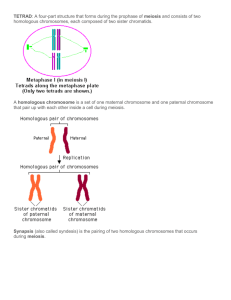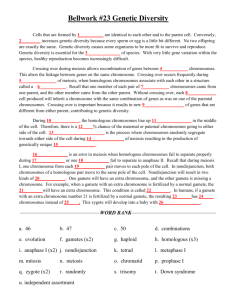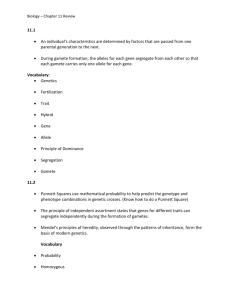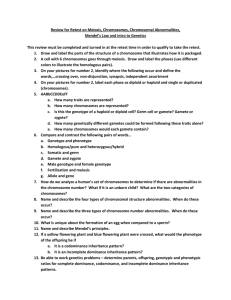trait homologous
advertisement
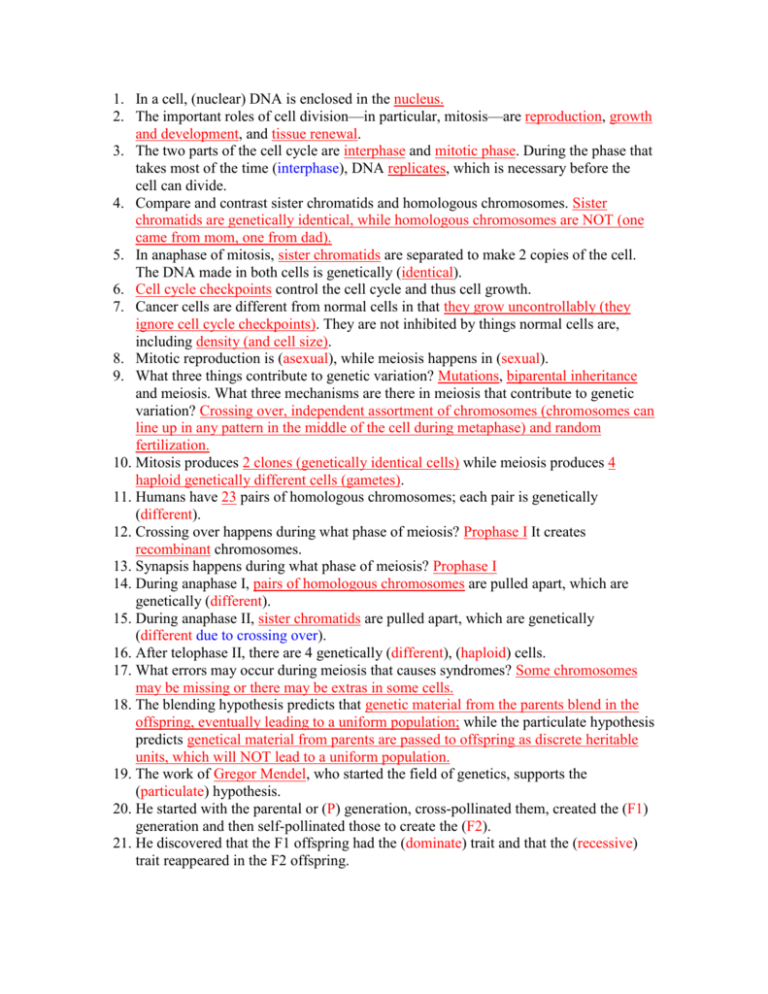
1. In a cell, (nuclear) DNA is enclosed in the nucleus. 2. The important roles of cell division—in particular, mitosis—are reproduction, growth and development, and tissue renewal. 3. The two parts of the cell cycle are interphase and mitotic phase. During the phase that takes most of the time (interphase), DNA replicates, which is necessary before the cell can divide. 4. Compare and contrast sister chromatids and homologous chromosomes. Sister chromatids are genetically identical, while homologous chromosomes are NOT (one came from mom, one from dad). 5. In anaphase of mitosis, sister chromatids are separated to make 2 copies of the cell. The DNA made in both cells is genetically (identical). 6. Cell cycle checkpoints control the cell cycle and thus cell growth. 7. Cancer cells are different from normal cells in that they grow uncontrollably (they ignore cell cycle checkpoints). They are not inhibited by things normal cells are, including density (and cell size). 8. Mitotic reproduction is (asexual), while meiosis happens in (sexual). 9. What three things contribute to genetic variation? Mutations, biparental inheritance and meiosis. What three mechanisms are there in meiosis that contribute to genetic variation? Crossing over, independent assortment of chromosomes (chromosomes can line up in any pattern in the middle of the cell during metaphase) and random fertilization. 10. Mitosis produces 2 clones (genetically identical cells) while meiosis produces 4 haploid genetically different cells (gametes). 11. Humans have 23 pairs of homologous chromosomes; each pair is genetically (different). 12. Crossing over happens during what phase of meiosis? Prophase I It creates recombinant chromosomes. 13. Synapsis happens during what phase of meiosis? Prophase I 14. During anaphase I, pairs of homologous chromosomes are pulled apart, which are genetically (different). 15. During anaphase II, sister chromatids are pulled apart, which are genetically (different due to crossing over). 16. After telophase II, there are 4 genetically (different), (haploid) cells. 17. What errors may occur during meiosis that causes syndromes? Some chromosomes may be missing or there may be extras in some cells. 18. The blending hypothesis predicts that genetic material from the parents blend in the offspring, eventually leading to a uniform population; while the particulate hypothesis predicts genetical material from parents are passed to offspring as discrete heritable units, which will NOT lead to a uniform population. 19. The work of Gregor Mendel, who started the field of genetics, supports the (particulate) hypothesis. 20. He started with the parental or (P) generation, cross-pollinated them, created the (F1) generation and then self-pollinated those to create the (F2). 21. He discovered that the F1 offspring had the (dominate) trait and that the (recessive) trait reappeared in the F2 offspring. 22. This lead to his belief that everyone has two “particles,” one from each parent. They are called alleles. Each “particle” is found on one chromatid in a pair of homologous chromosomes. During meiosis (anaphase I), the “particles” are separated. 23. Describe the Law of Segregation as it applies to the “particles” and to chromosomes. Alleles are segregated during gamete production so that each gamete has only one allele. Chromosomes are segregated during gamete production so that each gamete has only one of that chromosome. 24. Describe the Law of Independent Assortment as it applies to the “particles” and chromosomes. Each pair of alleles segregates independently of other allele pairs during gamete formation. Each chromosome segregates independently of other chromosomes during gamete formation as well—the orientation of the homologous chromosome pair (and sister chromatids) of meiosis is random. 25. You are given a purple flower. Purple is its (phenotype). Since purple is a dominant trait, you perform a test cross to determine its (genotype). 26. T or F: If a flower is pink but its parents were red and white, it is an example of pleiotropy. False—this is an example of incomplete dominance! 27. Compare and contrast pleiotropy and polygenic inheritance. For pleiotropy, MULTIPLE characters are affected by ONE gene; for polygenic inheritance, ONE character is affected by MULTIPLE genes. 28. Sickle cell disease is an example of pleiotropy. 29. Sutton’s Chromosome Theory of Heredity proposed that alleles (Mendel’s “particles”) are present at specific loci (locations) on chromosomes. 30. Morgan did many tests on flies. He discovered wild type and mutant phenotypes. Define those. Wild type traits are the normal, natural phenotypes. Mutant phenotypes are unusual and not found in nature. What is a “vestigial” trait? One that causes an organ to be small and degenerate resulting from a mutation. 31. Since the mutant phenotype was found only in males, Morgan discovered sex-linked traits which (supported) the chromosome theory of heredity. 32. What are “sex-linked” genes? How do they cause certain disorders? Sex-linked genes are those that are found on the sex chromosomes. Females have two X chromosomes and males only have one; if a disease is recessive on the X chromosome, males are more easily affected (they have either the dominant allele or the recessive allele, but females can have AA, Aa or aa). 33. What are linked genes? Do they follow Mendel’s Law of Independent Assortment? Those that are located on the same chromosome and thus tend to be inherited together. They do NOT follow the Law of Independent Assortment! 34. A dog that is heterozygous for two traits (i.e. BbHh) mated with a dog with recessive genes (bbhh). The majority of the puppies had the phenotypes of their parents. What does this suggest about the two traits? That they are linked! 35. Those puppies that didn’t have either parent’s phenotype are called recombinant offspring. 36. The probability of recombination depends on the distance between the genes on the chromosome and is higher when they are farther apart. 37. What is genomic imprinting? During gamete formation, some genes “silence” one of their two alleles (so it’s not expressed). It depends on whether the allele came from mom or from dad. (It is NOT considered “sex-linked”!)


